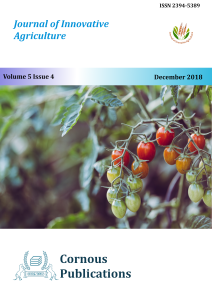
Journal of Innovative Agriculture
Peer Reviewed Open Access Journal
ISSN: 2394-5389 NAAS Rate: 4.05
Submit Manuscript
Peer Reviewed Open Access Journal
ISSN: 2394-5389 NAAS Rate: 4.05
Submit ManuscriptCassava is an important crop cultivated in most of the districts of Tamil Nadu, the starch content of cassava is high when compared with any other crops. The yield of cassava is drastically reduced due to infection with Sri Lankan cassava mosaic virus. In order to study the real impact of this virus on the yield, starch and protein contents of tubers, three field studies were conducted during two years from 2010-2012. Three different varieties namely H226, CO2 and Kunguma rose varieties were used for the study. Field trial was conducted at ARS Vaigai Dam TNAU Farm, Singampettai, SPAC Factory land (Erode district) with infected and healthy cassava plants (virus eliminated and indexed) for three consecutive seasons. During 2010 the trial with cv. CO2 in an area 0.5ac (25 cents healthy and 25 cents infected) was conducted and during second season (Oct-Nov planting) at SPAC Farm, Singampettai, Eroded district. The trial with Kunguma Rose (local) was conducted during first season (June-July 2011) at SPAC Farm, Singampettai, in an area of 0.5 Ac (25 cents healthy and 25 cents virus infected) and the trial with cv H226 was conducted at ARS, Vaigai Dam, Theni District during Feb 2012 in an area of 0.5 ac (25 cents infected and 25 cents healthy). The observation was recorded on the tuber yield and it was observed that there was a drastic reduction in the yield to the tune of 70, 37.6 and 79.9 per cent in cv CO2, Kunguma rose and H226 respectively. Qualitative yield loss was also recorded for the three varieties. The starch content of the tubers was found to be reduced to the tune of 10.4, 23.2 and 20.4 per cent in the cv CO2, Kunguma rose and H226 respectively. The protein content for all the varieties was found to be reduced to the tune of 0.15 per cent as in comparison with tubers collected from healthy plants.
Cassava mosaic disease, tuber yield, starch content, protein analysis
Abraham, A. 1956. Tapioca cultivation in India. Farm Bulletin No. 17. ICAR, New Delhi. 20 pp.
Alagianagalingam, M. N. and K.Ramakrishnan. 1966. Cassava mosaic in India. South Indian Horticulture, 14: 71–72.
Dasgupta, I., Malathi, V. G. and Mukherjee, S. K. 2003. Genetic engineering for virus resistance. Current Science, 84: 340-354.
Anonymous, FAO. 2006. www. Faostat.org.
Jeeva, M. L., 1997. Effect of secondary infection of cassava mosaic disease on growth and tuber yield of cassava. Journal of Mycology and Plant Pathology, 27(1): 78-80.
Koros, J.C1, Runo, S.M., Yusuf, M., and Orek, C.O. 2018. Screening Selected Cassava Cultivars for Resistance against Cassava Viruses and Cassava Green Mites under Advanced Yield Trials in Kenya. IOSR Journal of Biotechnology and Biochemistry (IOSR-JBB) ISSN: 2455-264X, Volume 4, Issue 5 (Sep. – Oct. 2018), PP 37-52. DOI: 10.9790/264X-0405023752.
Malathi, V. G., Nair, N. G. and Shanta, P. 1985. Cassava mosaic disease. Technical Bulletin Series 5, Central Tuber Crops Research Institute, Trivandrum, India, pp 18.
Malathi, V. G., Nair, N. G., Shanta, P., 1985. Cassava mosaic disease. Technical Bulletin Series-5, Central Tuber Crops Research Institute, Trivandrum, pp.18
Manivasagam, S., Rabindran, R., Balasubramanian, P. and Natarajan, S. 2006. Studies on Cassava mosaic disease with special reference to detection and virus variability. Presented in 14th Triennial symposium of ISTRC held at CTCRI, Thiruvananthapuram, Kerala. pp153.
Mathew, A. V. 1989. Studies on Indian cassava mosaic virus diseases. Ph.D. Thesis, University of Agricultural Sciences, Bangalore, India. pp 237.
Nair, N. G., Malathi, V. G., 1987. Disease severity and yield loss in cassava (Manihot esculenta Crantz) due to Indian cassava mosaic disease. Journal of Root Crops, 13(1): 91-94.
Thankappan, M., Chacko, C. I., 1976. Effect of cassava mosaic on the different plant parts and tuber yield in cassava. Journal of Root Crops, 2(2): 45-47.
Thottapilly, G., Thresh, J., Calvert, L. A., Winter, S., 2003. Cassava. In: Virus and virus-like diseases of major crops in developing countries, [ed. by Loebenstein, G., Thottapilly, G.]. Dordrecht, Netherlands: Kluwer Academic Publishers. 107-165.
